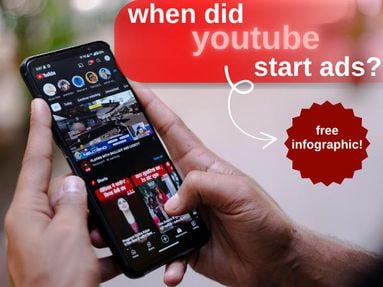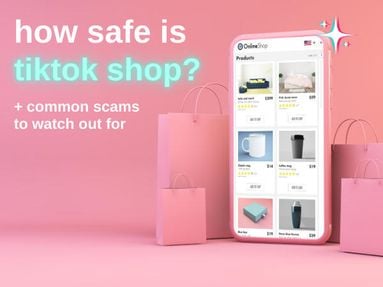Today, ads are synonymous with YouTube - but it wasn’t always that way. So when did YouTube actually start integrating ads into their content? Let’s take a look at the history of video advertising, plus some insight on how YouTube chooses the ads they show on videos.
Key Points:
How Old Is YouTube?
YouTube has been around since February of 2005, founded by Chad Hurley, Steve Chen, and Jawed Karim.
Originally bearing the slogan “Tune In, Hook Up”, YouTube was initially launched as a dating site. While the dating aspect of the site failed, the founders decided to lean in to the site’s video sharing aspect, which hadn’t been seen before, and a few months later the first YouTube video in history was uploaded.
The First YouTube Video
On April 23, 2005 the first ever YouTube video was uploaded to the site. Titled Me at the zoo, the video shows YouTube co-founder Jawed Karim in front of the elephant enclosure at the San Diego Zoo.
While it’s only 15 seconds long, the video has since accrued over 373 million views and 18 million likes. It’s also the only video uploaded to Karim’s channel, which stands at 5.73 million subscribers.
How Did YouTube Look In 2005?

In its early days, YouTube had a much simpler layout that featured the site’s logo (as designed by Chad Hurley), along with a few tabs for the home page, favorites, messages, videos, and profile page. Users could log in with their screen name and password, or visit the help page for additional assistance.
There were also a variety of metrics visible on video pages, particularly in the comments section. Not only could users see a videos’ rating and comment count, but backlinks were also visible. Within the comments section it was possible to see the number of videos, favorites, and friends individual commenters had.
Around this time, the site’s slogan also changed from “Your Digital Video Repository” to “Broadcast Yourself”.
When Did YouTube Start Monetizing?

2005-2010
YouTube initially strayed away from in-video advertising, with the first ads being participatory video ads that encouraged users to click them in exchange for exclusive content. Rather than appearing before videos that viewers were trying to watch, these participatory ads were actual videos themselves.

The first participatory video ad was for the show Prison Break, and appeared in February 2006 above videos on Paris Hilton’s channel, which was operated by Warner Bros. Records at the time.
By October 2006, YouTube was purchased by Google, followed by a variety of changes to the site’s layout and functionality.
At the end of 2007, the YouTube Partner Program was launched, allowing creators to earn money by running ads on their video content. The Partner Program is still in effect today, and its requirements of 1,000 subscribers and 4,000 watch hours remain unchanged.
In 2008, users had the ability to choose whether or not they wanted to watch an ad before their video, thanks to the inclusion of “TrueView” ads.
During this time, pre-roll ads about 15 seconds long were most common. These were unskippable and required no interaction, so viewers could not pause or rewind them. From the advertiser’s side, options were also limited, and targeting was done mostly with video categories and broad demographics which meant many ads were ineffective.
2010-2020
By 2010 YouTube introduced online film rentals, and alongside this ad options began expanding. Soon advertisers were able to choose from pre-roll, mid-roll, and banner ads, along with cards and end screens. Targeting was also improved, and soon incorporated watch history, device time, and interests along with video categories and other demographics.
Outstream video ads began gaining popularity, as they allowed publishers to reach a wider audience and to monetize videos without having to create their own content.
During this period, YouTube was ranked as the third most visited site on the internet, after Google and Facebook, and reported over 4 billion videos streamed per day, with 60 hours of footage streamed per minute.
By March 2013, YouTube had over 1 billion monthly unique visitors, and showed no signs of slowing down as additional features were added for both creators and viewers, including music streaming and video scheduling.
2020-Present
As YouTube continued to expand in viewership the site became progressively more streamlined, with subscriber, view, and like counts becoming abbreviated. Categories were also removed, as was the ability to send direct messages between regular users, and - controversially - the dislikes count was hidden.
YouTube Shorts were eventually integrated into the YouTube Partner Program, with their own monetization requirements.
In regards to advertising, YouTube has begun using AI algorithms to detect viewer behavior and habits, and serve even more targeted ads. New placements for ads have also been integrated, with TrueView Discovery ads and responsive video ads adapting to different placements on certain devices. Unlike early ads on YouTube, these ads are skippable and often feature a countdown timer.
What Was The First Video To Get Ads On YouTube?
In its early days, the YouTube Partner Program had only accepted about 100 YouTubers into its monetization program, many of them being brands.
One of the first individuals to be accepted to this program was Tay Zonday, whose video Chocolate Rain was among the first to get ads:
Zonday’s video was published on April 22, 2007 and currently boasts over 141 million views.
When Does YouTube Start Putting Ads On Your Videos?
Nowadays, creators can choose whether or not to include ads on their video content. To do so, they first need to be part of the YouTube Partner Program.
Currently, there are two paths towards monetization in the YPP.
If you opt to create longform YouTube videos, you’ll need:
- 1,000 subscribers
- 4,000 watch hours in the last 12 months (excluding Shorts)
If you opt to create YouTube Shorts, you’ll need:
- 1,000 subscribers
- 10 million Shorts views in the last 90 days
Once you meet these requirements, you can apply for consideration in the YouTube Partner Program and, if you’re accepted, you can choose your monetization features, adjust your ad preferences, and get paid through Google AdSense.
How To Apply To The YouTube Partner Program
- Open YouTube Studio on desktop or via the YouTube Studio app.
- Select Earn.
- Select Apply Now.
- Select Start and accept the terms to begin the process.
Follow the on-screen instructions to set up your AdSense account and complete the application.
How Does YouTube Decide Which Ad To Show?
YouTube ad targeting takes a variety of factors into account, including:
- Age
- Location
- Gender
- Viewing history
- Browsing history
- Video interaction
- Whether you’re signed in or not
Advertisers can choose which of these areas to target when creating the ad which determines which videos they’re placed on, and in front of which users.
Frequently Asked Questions
Did YouTube have ads in 2007?
Yes, in fact YouTube started having ads as early as 2006.
Who was in YouTube Rewind 2016?
YouTube’s 2016 Rewind video featured the following creators:
-
Alex Wassabi / hoiitsroi
-
Alfie / pointlessblog
-
AIB / allindiabakchod
-
AmazingPhil / amazingphil
-
AndreasChoice / andreaschoice
-
Bethany Mota / macbarbie07
-
BFvsGF / bfvsgf
-
BibisBeautyPalace / bibisbeautypalace
-
Bie The Ska / bomberball
-
CaELiKe / caelike
-
Casey Neistat / caseyneistat
-
Caspar / dicasp
-
Connor Franta / connorfranta
-
Cyprien / monsieurdream
-
danisnotonfire / danisnotonfire
-
Dude Perfect / corycotton
-
Dwayne "The Rock" Johnson / therock
-
EeOneGuy / eeoneguy
-
elrubiusOMG / elrubiusomg
-
enchufetv / enchufetv
-
Gigi Gorgeous / gregorygorgeous
-
Grace Helbig / graciehinabox
-
hajimesyacho / 0214mex
-
Hannah Hart / myharto
-
Hayla / haylatv
-
Hevesh5 / hevesh5
-
HolaSoyGerman / holasoygerman
-
iHasCupquake / ihascupquake
-
Ingrid Nilsen / missglamorazzi
-
jacksepticeye / jacksepticeye
-
Jenn McAllister / jennxpenn
-
Joey Graceffa / joeygraceffa
-
JoutJout Prazer / joutjoutprazer
-
KianAndJC / kianandjc
-
KSI / ksiolajidebt
-
Kurt Hugo Schneider / kurthugoschneider
-
LaurDIY / laurdiy
-
Lilly Singh / iisuperwomanii
-
Liza Koshy / @lizakoshy
-
LosPolinesios / lospolinesios
-
Luisito Rey / luisitorey
-
Luzu / luzugames
-
Mamrie Hart / youdeserveadrink
-
Markiplier / markipliergame
-
Marques Brownlee / marquesbrownlee
-
MatPat / matthewpatrick13
-
Matt Steffanina / mattsdance
-
Meg DeAngelis / maybabytumbler
-
Meredith Foster / stilababe09
-
Nicky Jam / @nickyjamtv
-
PewDiePie / pewdiepie
-
PIKOTARO / @pikotaro
-
Porta dos Fundos / portadosfundos
-
PrankvsPrank / prankvsprank
-
RADIO FISH / @radiofishunion
-
Rclbeauty101 / rclbeauty101
-
Rhett & Link / rhettandlink
-
Sebastián Villalobos / villalobossebastian
-
Seth Meyers / latenightseth
-
SQUEEZIE / amoodiesqueezie
-
sWooZie / swoozie06
-
The Dolan Twins / thedolantwins
-
The Late Late Show with James Corden / @thelatelateshow
-
The Slow Mo Guys / theslowmoguys
-
TheWillyrex / thewillyrex
-
Tre Melvin / thisisacommentary
-
Trevor Noah / @thedailyshow
-
Unbox Therapy / unboxtherapy
-
VanossGaming / vanossgaming
-
VRZOchannel / vrzochannel
-
Werevertumorro / werevertumorro
-
What's Inside? / lincolnmarkham
-
whatdafaqshow / whatdafaqshow
-
WhinderssonNunes / whinderssonnunes
-
YosStoP / yosstop
-
Yuka Kinoshita / kinoyuu0204
-
Yuya / lady16makeup
Who was the most popular YouTuber in 2017?
PewDiePie was the most popular YouTube in 2017, with over 54 million subscribers.
Who is the 8 year YouTuber 26 million?
Ryan Kaji, host of the YouTube channel Ryan’s World, was YouTube’s highest earner in 2020 with an estimated $29.5 million in earnings.
When did Google buy YouTube?
Google bought YouTube in October 2006 for $1.65 billion in stock.
When did YouTube become popular?
YouTube became popular almost instantly. By April 2005, just two months after launch, YouTube was seeing over 30,000 viewers a day and by July of the same year it was seeing over 100 million views a day.


